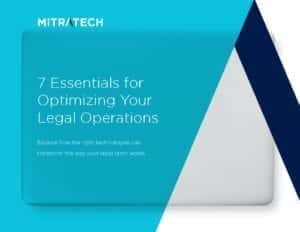7 Essentials for Legal Operations Optimization, Part One
Legal Operations optimization has become vital. Why? As one of the most highly trained and skilled divisions within an organization – and frequently the most trained and skilled – the legal department, and the Legal Operations team supporting it, are under enormous pressure to perform.
CEOs and senior management increasingly like to see their legal departments demonstrating leadership by exploring ways to run their operations more effectively in order to add strategic value to the rest of the organization.
One of the major ways for Legal Operations managers and teams to accomplish this goal? By embracing technology.
To the extent they can, legal department leaders should be looking for opportunities to embrace the rising practice area of Legal Operations and actively demonstrate how technology solutions can drive down inefficiencies, reduce costs, and promote growth through increased insight and smarter planning.
Let’s explore how legal professionals who are introducing Legal Operations into their departments are increasingly looking to legal matter management, e-Billing, and TAP Workflow Automation technologies to help them work toward solving many of the issues just mentioned.
Here are three essential areas where Legal Operations optimization can deliver maximum value to an organization, and how technology can help Legal Operations managers and teams achieve it.
 Implement a consistent process for opening new matters
Implement a consistent process for opening new matters
As we outlined above, legal departments are under ever-increasing scrutiny to be one of the best-run divisions in the organization. One way of accomplishing it? Legal Operations optimization should involve making aspects of the matter management process more efficient.
Faced with the challenge of opening, assigning and managing new matters from across the organization, many legal teams are recognizing that the legacy/homegrown or manual systems they’ve been using present a serious roadblock to smooth operations: They just aren’t able to embed or account for legal best practices.
When the routine processes of opening matters, managing workflow and reporting matter progress are decentralized, they burden the legal department staff. They bog down attorneys, paralegals, and operations staff with mundane, repetitive manual tasks and searches for missing information.
Solution
Today, legal matter management technology enables legal teams to solve these challenges, with three key benefits from implementation:
- Reducing effort to open new matters. By automating matter opening, our clients can use templates and create standards to normalize matters across the legal department. This reduces the time to open a new matter from 60 minutes to 15 minutes.
- Establishing a single source of truth. A centralized location for all matter data ensures a complete and accurate database. Beyond solely access to better data, a legal matter management solution provides comprehensive search and reporting capabilities for the legal department to use to standardize work and identify trends to improve results and outcomes over time.
- Proactively managing costs. Because all matter data is centralized, it allows the legal department to matter manage workload and improve load balancing between both staff attorneys and firms. Ensuring that counsel are working with the firms that provide the highest value to the legal department and optimizing the work that is done by in-house staff can save the organization 1.5% in external legal spend annually.
 Automate the process for invoice review and approval
Automate the process for invoice review and approval
One of the biggest cost centers within legal is the spending related to working with outside counsel. Not surprisingly, legal departments face increased budget scrutiny, and there are expanded expectations about the accuracy of outside counsel management.
In today’s environment, your General Counsel needs better visibility into spend, and more predictability built into the planning process.
That means being predictable with legal spend forecasts and effective in the engagement and management of outside counsel relationships. With outdated manual spend management and e-Billing processes, legal teams are often devoting too much valuable time to low-value tasks such as:
- Processing, reviewing, and approving invoices
- Enforcing billing guidelines
- Responding to law firm inquiries
- Resolving disputes from incorrect, incomplete, or tardy invoice submission
In order to deliver a forecast with certainty, your team needs to receive updates and accruals from outside counsel. Without real-time visibility or collaboration on matter work in progress, you’re left in the dark wondering if a matter will come in over budget, over time, or over scope.
When the invoice is received, it’s often long after the work is performed, further hindering the review of the invoice and leading to further back-and-forth conversations and disputes. Even after guidelines are established for the firms you do business with, it becomes hard to recognize whether or not they’re being consistently followed.
Solution
With a proactive strategy for managing legal spend that includes an up-to-date e-Billing solution, a Legal Operations team can pivot from mundane tasks like invoice review to highlighting the strategic value the legal department delivers to the organization. Legal Operations optimization through management and automated invoice workflow capabilities can help you execute on these priorities in specific areas:
- Processing, reviewing, and approving invoices. By increasing visibility and tracking, the organic improvement in billing practices results in optimized spend, reduced disputes and enhanced relationships.
- Enforcing billing guidelines. By embedding billing guidelines, questionable line items are flagged for review, enabling invoice reviewers to quickly sort through the invoice and adjust or reject. Over time, your top law firms will understand and improve their billing procedures due to the increased scrutiny around spend. This benefit alone can reduce legal spend by as much as 3% annually.
- Streamlining communications with outside counsel. Electronic billing can expedite the payment process and help law firms comply with your requirements and expectations. Utilizing an e-Billing solution will allow you to take advantage of AFA’s and Early Pay Discounts. It will also reduce the number of inquiries through e-mail and phone calls around invoice processing and payment. It may not transform outside counsel relationships overnight, but it does create opportunity to streamline current processes, reduce staff time waste, eliminate duplicate payments, and enforce negotiations.
 Begin tracking KPIs with dashboards that make progress visible to the entire team
Begin tracking KPIs with dashboards that make progress visible to the entire team
As legal departments become increasingly business oriented, it has become a standard best practice to gauge performance and outcomes using Key Performance Indicators (KPIs).
One of the ways to drive better outcomes through this methodology is to bring greater awareness of KPIs – exactly what they are and which goals they’re driving towards – to your team.
Yet it’s important to understand this: The way KPIs are used to steer decision-making within an organization using legal management technology is going to be significantly more effective than when KPIs are employed by an organization that’s not using this technology. Why? Because the data that’s essential to hitting KPIs is surfaced to the entire team through the dashboarding functions these solutions provide.
Some of the common KPIs that teams new to Legal Operations will want to start with will track and answer questions about:
- The number of open matters, their stage and status to get to average days open by matter type/category.
- Assigned matters by staff member and firm to get to resource allocation and optimization over time.
- Year-to-date legal spend and legal spend by matter type, to enable over year-over-year reduction of overall spend.
These metrics can certainly be useful, but as a legal department becomes more business- and tech-savvy, the questions it asks become correspondingly more complex. With today’s more advanced legal solutions you can move beyond simply reporting on metrics to answering these critical questions:
- “Are we getting the best value for this work?”
- “How are we doing against our usual trends?”
- “Which outside counsel firm are we utilizing for our litigation matters, and what percentage of those matters have returned favorable results for us?”
Solution
Most industry-leading legal operations automation systems today offer standard and interactive dashboards that provide real-time reporting and visibility into standard and advanced reports that track to conventional KPIs. As expert analysts like Kevin Clem of HBR have pointed out, these can be a game-changer.
As legal operations and automation transforms many previously manual-oriented tasks, these dashboards also offer an easy way for team members to document performance and progress to senior executives on what formerly would have been hard to analyze or obscure. Examples of how this plays out?
Example: Reducing matter lifecycle. How long does it take the legal team to process a legal matter from open to close? Decision makers like to compare this KPI against industry averages because it is applicable to a number of areas. For example, how long is it taking the department to close litigation cases against the historical average? Or how long is it taking for the department to review and redline contracts now compared to the past?
Monitoring these cycle times can provide key insight into how responsive the department is to its business partners. Or, in the case of litigation, helps determine if the department is doing all it can to settle cases before they incur heavy outside counsel fees.
Example: Keeping team members on task. Related to cycle times, it’s important to ensure that legal matters don’t slip through the cracks and become major liabilities. Toward this end, reports for KPI tracking enables to you create visibility across the team that alerts attorneys to matters that sit idle for too long. “Tickler reports” distributed to targeted team members ensure that nothing is being missed, and there are no blind spots in your department.
The ability to understand and visualize these key trends allows you, as a Legal Operations professional, to proactively manage and address any trends that are detrimental to your department’s performance.
More ways to optimize your Legal Operations?
In Part Two of this series on Legal Operations optimization, we’ll deep-dive into even more areas where Legal Ops teams can extract greater efficiency and performance using today’s available technologies.
Or you can download the complete list in a new, in-depth ebook, 7 Essentials for Optimizing Your Legal Operations.




